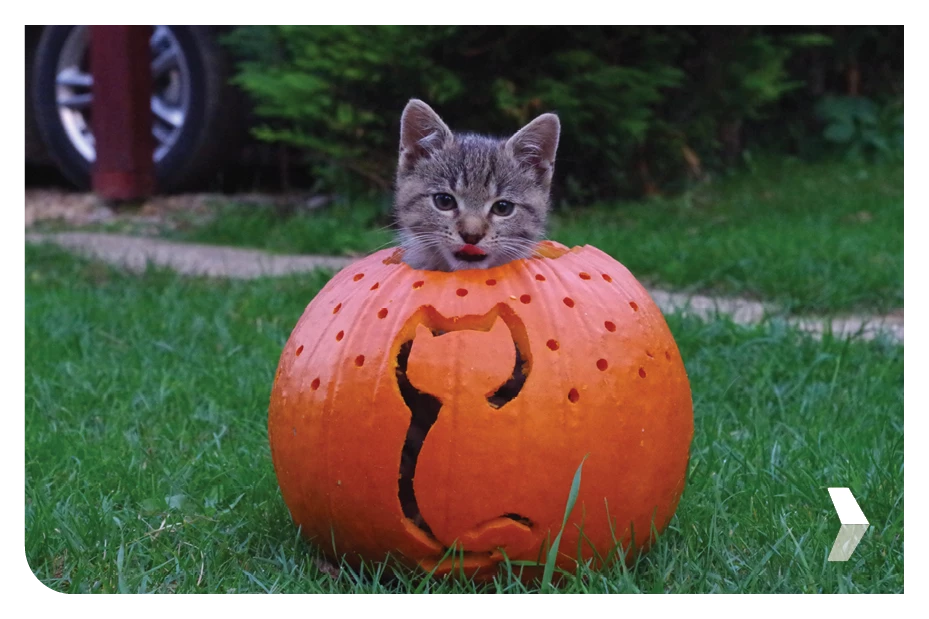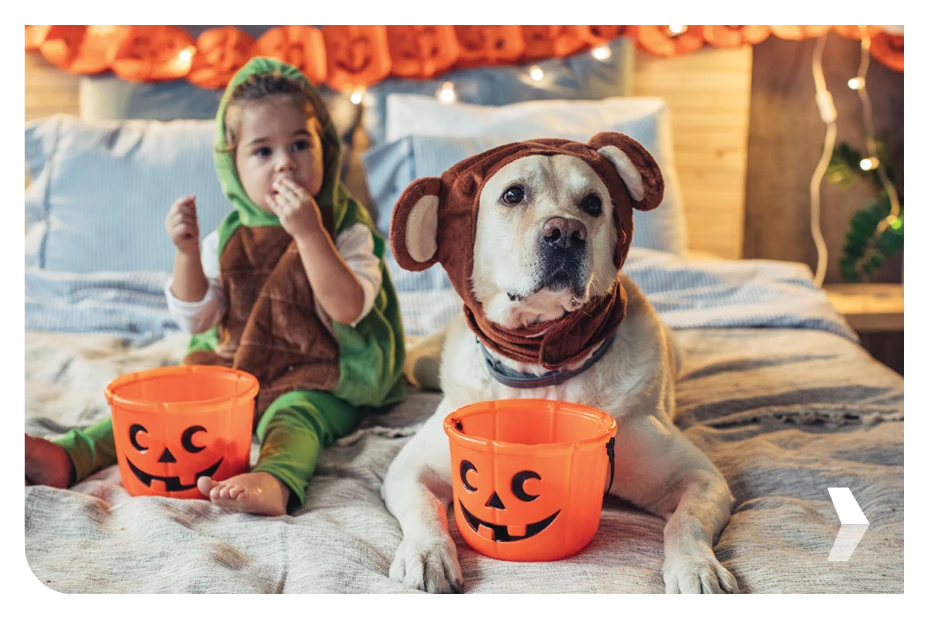Hide the Chocolate! Halloween Hazards for Pets
Lorie Adams, Sr. Mortgage AdvisorOctober 10, 2022 — 8 min read

Candy, costumes, and frights are fun this time of year, but our pets might not agree. For our four-legged friends, unusual sights, sounds, and strangers interrupt their normal routine, which may make them feel uncomfortable and frightened. It's our job to protect them against Halloween hazards for pets. From knowing what to do if your dog eats chocolate, to how to find a lost pet, use these pet safety tips to ensure that everyone--including your furry friend--has a spooktacular time this year.
Halloween Hazards for Pets: Avoid These Items
Did you know the week of Halloween is the Pet Poison Helpline's busiest time of year? In fact, during the week of Halloween, emergency care and toxicology calls increase by approximately 12 percent, according to experts. Additionally, if you've ever struggled to find a lost pet, you're not alone--Halloween is the second most common holiday for pets to get lost. Below, we share pet safety tips to help you avoid Halloween hazards for pets.
Pet safety tips (#1): Trick-or-treat candies aren't for dogs or cats.
Candy and sweets, particularly those containing xylitol, are toxic if ingested by a cat or dog. Xylitol is a sugar-free sweetener added to some candies, mints, gum, and some brands of toothpaste; if ingested, it can cause hypoglycemia. Symptoms include depression, vomiting, diarrhea, and weakness.
Chocolate is also toxic to animals, especially dogs. The darker and more bitter the chocolate, the more poisonous it is (if you're wondering what to do if your dog eats chocolate, there are instructions on that below). Unfortunately, many dogs are inherently attracted to the taste and smell of chocolate. If ingested, symptoms include vomiting and diarrhea, restlessness, muscle tremors, or seizures. In some cases, if an animal eats enough, it could die.
According to the Pet Poison Helpline, over the past year, more than 1,100 calls involved exposure to chocolate; of those calls, 98 percent involved dogs.
Grapes and raisins are also big Halloween hazards for pets; if ingested, even a very small amount of either snack can cause kidney failure in a dog or a cat.
Finally, ingesting candy wrappers, particularly those with foil, could cause a bowel obstruction; if severe enough, it could require emergency surgery. If you think your pet ingested a candy wrapper, watch for vomiting, difficulty defecating, decreased appetite, and lethargy, among other symptoms.
When it comes to candy--whether hard, chewy, chocolate, or grapes or raisins--it's best to store it in a lockable container outside of your pet's reach. You should also remember to be careful with candy wrappers by either placing them out of reach of your pet or putting a cover over your waste baskets for the night.
Pet safety tips (#2): Glow sticks and glow jewelry aren't for dogs or cats.
Pets love to chew on things, particularly if they're small and plastic. This means that while glow sticks and jewelry are festive this time of year, they're also potentially dangerous Halloween decorations if you have a dog or cat at home.
Here's why: the chemicals inside of a glow stick or an item of glow jewelry can also cause skin and/or eye irritation. This is a significant concern for cats and may result in a larger amount of ingestion as they lick themselves to clean it off themselves.
Over the past year, the Pet Poison Helpline reported nearly 80 calls involving pets that punctured glow sticks or glow jewelry; of those calls, 70 percent involved cats.
Common symptoms and signs to watch out for include:
- Redness to the eyes or skin
- Vomiting and/or retching
- Excessive drooling
- Gagging

Pet safety tips (#3): Lit candles? Those aren't for dogs or cats either.
Open flames are common this time of year, but they still top our list of Halloween hazards for pets. While an open flame may add to the allure of the holiday, they're particularly dangerous if your pet is frightened, makes a sudden movement, or accidentally brushes by the open flame. If this is a concern for your cat or dog, LED candles or other battery-operated lights may be a smarter choice.
What to Do If Your Dog Eats Chocolate
Chocolate is one of the biggest Halloween hazards for pets--if you catch your pet in the act, or find out they've eaten chocolate within a few hours of ingestion, bring them to a vet immediately or try to include vomiting yourself. The only safe way to get a dog to vomit at home is by using hydrogen peroxide, according to experts. If you decide to induce vomiting at home, do not use salt or olive oil to make your pet throw up, and don't stick a finger or an object down their throat. If you're not sure if they've eaten chocolate but suspect they may have, keep your animal close and watch for symptoms.
Take your pet to see a doctor if they have prolonged vomiting or retching, excessive diarrhea, tremors, seizures, or if you notice other strange behavior. While you're there, talk with the doctor about what to do if your dog eats chocolate--no one knows your animal better. Once you know your pet is safe, make sure they're hydrated, as toxins dehydrate and exhaust the body.
Some forms of chocolate are more dangerous than others. Here are toxic levels of chocolate by weight for the most common types:
- Baking chocolate: 0.5 ounces per 10 pounds
- Dark chocolate: 1.5 ounces per 10 pounds
- Milk chocolate: 3.5 ounces per 10 pounds
- White chocolate: 47 pounds per 10 pounds
If you're unsure of what to do if your dog eats chocolate, the Pet Poison Helpline is available at 855-764-7661. The ASPCA Animal Poison Helpline is available at 888-426-4435. Both services are available at any hour of the day and every day of the year.
Halloween Hazards for Pets: Safety Considerations for Pet Costumes
Candy aside, pets in cute costumes are one of the best parts of this time of year. However, our four-legged friends may not enjoy it as much as we do. If you dress your animal up, make sure the costume doesn't restrict their line of sight, movement, or breathing. Your pet should be able to walk, bark, meow, and see and hear clearly. Additionally, make sure the costume doesn't have metallic beads, snaps, or other small pieces; if ingested, these could result in serious poisoning.
Keep in mind that if your pets not having fun, you probably won't either. Only dress them up if you're sure they're going to be comfortable and not too stressed. These tips will help build trust between you and your animal, and these steps will help them feel comfortable and safe while wearing their costume:
- Introduce your pet to their costume before the big day and offer treats while they wear it to create a positive association.
- Cats and dogs communicate through body language, and if they're in a costume, it may restrict that. Pay close attention to their body language.
- If your cat or dog freezes, offer them treats or a toy so they know that they can move while wearing it.

How to Find a Lost Pet
Before the holiday hits, make sure your pet is wearing an identification tag. Even if they have a microchip, it's a good idea to have them wear an identification tag, as it may help get them home sooner. If you're up for a home project, create a safe place for your pet to retreat with these indoor dog house ideas.
For pets with a microchip, make sure their registration and your contact information are up-to-date. If you're feeling festive, you can visit the pet store before Halloween arrives to purchase a Halloween-themed pet ID. You may also want to take other precautions, like having them wear a reflective collar.
If you can't find your animal, here are some ideas on how to find a lost pet:
- Check neighbors' yards and green spaces before expanding your search perimeter. Tell everyone you meet that you're searching for a lost dog, and if possible, distribute photos.
- Knock on doors, hang posters, and distribute contact information to mail carriers, joggers, newspaper delivery people, and anyone else who frequents in the neighborhood. With permission, hang notices at grocery stores, vet offices, dog parks, or pet supply stores. Use social media to spread the word in neighborhood groups.
- Contact local animal control and visit local animal shelters.
- Check online resources, such as Pet FBI, FidoFinder, Center for Lost Pets, or Craigslist to see if someone has found your pet and is searching for its owner.
Have Questions?
Taking care of another living being is enough to keep anyone on their toes. For more tips to keep your home and your pet safe, check out our Holiday Home Safety Checklist or reach out to your neighborhood Mortgage Advisor.
Keywords:
Categories
Archives
Recent Posts
- No Down Payment for First-Time Homebuyers
- How Does A 30-Year Mortgage Work: A Simple Guide
- Your Comprehensive Homebuying Checklist: A Step-By-Step Guide
- Mortgage Pre-Approval: Everything You Need to Know
- What Are the Benefits of a USDA Loan for Homebuyers?
- How Many People Can Be On A Home Loan? Your 2024 Guide
You bring the dream. We'll bring the diagram.
There’s a financing solution for just about every situation.
I felt like I was treated like family, great communication and helping me with any questions I had.

You bring the dream. We'll bring the diagram.
There’s a financing solution for just about every situation.
Where does your sun shine? Find your local advisor.
Enter your city or state to see advisors near you.
